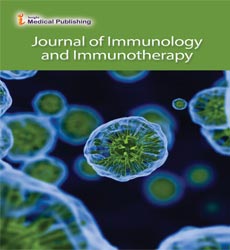Immune Administration by the Non-Immune Cells
Ethan Fisher*
Editorial office, Journal of Immunology and Immunotherapy, United Kingdom
- *Corresponding Author:
- Ethan Fisher Editorial office, Journal of Immunology and Immunotherapy, United Kingdom E-mail: jmso@emedicinejournals.org
Received Date: August 10, 2021; Accepted Date: August 18, 2021; Published Date: August 29, 2021
Citation: Fisher E (2021) Immune Administration by the Non-Immune Cells. J Immuno Immnother. Vol.5 No.4:17.
Perspective
The immune system is a highly sophisticated system that regulates a significant portion of the host's defensive and regenerative responses to external and internal microorganisms, toxins, and other threats. Dendritic cells, macrophages, neutrophils, eosinophils, innate lymphoid cells, T cells, and B cells are examples of innate and acquired immune cells. Specific antigens stimulate B and T cells, which then arrange the most effective form of immune response by removing unwanted events. Phagocytic cells, such as dendritic cells and macrophages, are important in both (i): Antigen-specific activation of lymphocytes and (ii): Situation-specific functional aberrations of lymphocytes. Non-immune cells, on the other hand, such as epithelial cells, epidermal keratinocytes, mesenchymal cells, stromal cells, synoviocytes, and neurons, are expected to contribute to the host's defense system not only as structural architectures, but also as regulators and effectors of its protective immune response. For example, chemicals produced by injured non-immune cells can influence a variety of immunological responses. Furthermore, non-immune cells de novo synthesis of bioactive mediators in response to various stimuli may be implicated in these processes. As a result, deficiencies in non-immune cells ability to mediate immune control may play a role in the pathogenesis of a number of inflammatory disorders. Non-immune cells must receive each sort of danger signal correctly, interpret it properly, and trigger the most suitable form of immune response to overcome that threat throughout the immune regulation process. However, the specific cellular processes involved in this process are yet unknown. As a result, there is a need for a review series that investigates a common mechanism of immunity control by nonimmune cells.
Skin
It was discovered that epidermal keratinocytes are positioned in the skin's outermost layer and are the first to respond to external chemicals and skin damage. They concentrated on the possible involvement of type 1 Interferon’s (IFNs) in psoriasis, one of the most prevalent chronic inflammatory disorders. Through different methods, skin injuries can rapidly generate IFN from keratinocytes and IFN from dermal plasmacytoid dendritic cells. Keratinocyte-derived IFN stimulates dendritic cell maturation and subsequent T-cell proliferation, resulting in the development of psoriasis.
Keratinocytes can be engaged in the organization of skin immune responses in two stages: the activation of primary immune responses and the propagation of secondary reactions, which leads to the chronic inflammation loop. TNF Receptor-Associated Factor 6 (TRAF6) is an ubiquitin E3 ligase that is required for NF-B and Mitogen-Activated Protein Kinase (MAPK) signaling pathways. The above-mentioned short review discusses TRAF6's functions in epithelial tissues, particularly keratinocytes, in both primary and secondary epithelial responses.
Mucosal Tissues
Numerous antigens, including commensal and pathogenic bacteria, are always present in the gastrointestinal tracts. The lumen of the epithelial monolayer that covers the gastrointestinal system includes luminal antigens. As a result, epithelial layer disturbance predisposes individuals to the development of Inflammatory Bowel Disease (IBD). Internal Nuclear Factor-B (NFB) signaling is a biological signaling pathway that governs Intestinal Epithelial Cell Homeostasis (IECs). According to some studies, IECs have the capacity to regulate the mucosal immune system and build a physical barrier. They also discussed how IECs modulate immune responses to luminal antigens, including commensal and pathogenic bacteria. IECs also generate antimicrobial compounds such as bactericidal peptides, immunoglobulin (IgA), and carbohydrate moieties. Cytokines and chemicals generated by immune cells in the lamina propria promote the production of these compounds. As a result, in order to maintain gut homeostasis, IECs act as bidirectional transducers of signals from luminal antigens and gut immune cells.
The lungs also have mucosal tissue that is made up of epithelial cells, stromal cells, and immune cells. They gave an excellent example of the molecular process underpinning inducible Bronchus-Associated Lymphoid Tissue induction (iBALT).
Interleukin (IL)-33 stimulates ST2+ memory CD4+ T cells, inducing IL-5 and amphiregulin in the setting of allergic inflammation. These cytokines hasten fibrosis and asthma pathogenesis. As a result, interactions between immunological and epithelial/ mesenchymal cells are crucial in the development of chronic lung inflammation.
Joints
Synovial tissue is a membranous, non-immune tissue that lines the joint cavity. The main non-immune cells in synovial tissues are Fibroblast-Like Synoviocytes (FLSs). FLSs, through numerous pathways, mostly contribute to joint deterioration in chronic inflammatory disorders such as Rheumatoid Arthritis (RA).
Stroma and Fat
By detecting pathogens and tissue injury, coordinating leukocyte recruitment and activity, and facilitating immune response resolution and tissue healing, stromal cells supplement the tasks of classical immune cells. Several members of the IL-6 cytokine family facilitate interaction between stromal and immune cells, and they perform multiple inflammatory and homeostatic functions. The preceding review highlights our current understanding of how IL-6 family cytokines govern stromalimmune crosstalk in healthy and sick hosts, as well as how these interactions might be exploited for therapeutic benefit.
Blood Vessels
At this time, the processes of atherogenesis remain mainly unknown. However, it has been shown that disease development requires interaction between immune cells and endothelial and Vascular Smooth Muscle Cells (VSMCs). In the media layer of arteries, VSMCs preserve the arterial wall's integrity. They also have a role in the remodeling of the artery wall at all phases of atherosclerosis.
Open Access Journals
- Aquaculture & Veterinary Science
- Chemistry & Chemical Sciences
- Clinical Sciences
- Engineering
- General Science
- Genetics & Molecular Biology
- Health Care & Nursing
- Immunology & Microbiology
- Materials Science
- Mathematics & Physics
- Medical Sciences
- Neurology & Psychiatry
- Oncology & Cancer Science
- Pharmaceutical Sciences
